Trụ biểu
Trụ biểu (chữ Hán: 柱表) is a type of traditional Vietnamese gateway, this type of gateway is easy to see in front of đình, mausoleums or temples in Vietnam.
| Trụ biểu | |
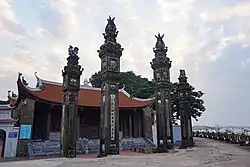 | |
| Vietnamese alphabet | Trụ biểu |
|---|---|
| Chữ Hán | 柱表 |
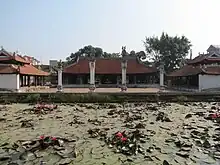
Trụ biểu at đình Tây Đằng

Trụ biểu at tomb of Gia Long
Features
The trụ biểu are usually rectangular in shape, the top part is pointed, decorated with lotus buds, lanterns or traditional Vietnamese mascots such as nghê, kỳ lân,...[1][2][3] The two middle pillars are always tall more than two adjacent pillars. On the body of the pillars are mounted, inlaid, and embossed with parallel sentences in chữ Hán.[4]
Most đình have trụ biểu, they are a common symbol of the village's spiritual culture,[5] the highest structure and the point that determines the location of the đình.[6]
Gallery
 Trụ biểu at Phù Mỗ Temple
Trụ biểu at Phù Mỗ Temple Trụ biểu at Thiên Mụ Temple
Trụ biểu at Thiên Mụ Temple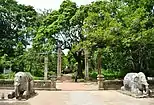 Trụ biểu at Tomb of Lê Thái Tổ
Trụ biểu at Tomb of Lê Thái Tổ Trụ biểu at đình Ba Đồn
Trụ biểu at đình Ba Đồn Trụ biểu at đình Mai Xá
Trụ biểu at đình Mai Xá Trụ biểu at đình Cổ Mân
Trụ biểu at đình Cổ Mân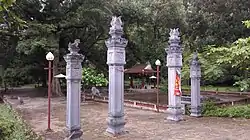 Trụ biểu at Lady Triệu Temple
Trụ biểu at Lady Triệu Temple.JPG.webp) Trụ biểu at Tomb of Minh Mạng
Trụ biểu at Tomb of Minh Mạng Linh Quang Buddhist Center, Nebraska, USA
Linh Quang Buddhist Center, Nebraska, USA_(4).jpg.webp) Trụ biểu at Trúc Lâm Temple
Trụ biểu at Trúc Lâm Temple Trưng Sisters Temple gate (a popular variation of Trụ biểu)
Trưng Sisters Temple gate (a popular variation of Trụ biểu) Đình Tứ Kỳ gate (a popular variation of Trụ biểu)
Đình Tứ Kỳ gate (a popular variation of Trụ biểu) Đình Đại Vi gate (a popular variation of Trụ biểu)
Đình Đại Vi gate (a popular variation of Trụ biểu)_(3).jpg.webp) Đình Tây Trì gate (a popular variation of Trụ biểu)
Đình Tây Trì gate (a popular variation of Trụ biểu) The gateway of đình Thổ Khối (variation of Trụ biểu), Hanoi, Vietnam
The gateway of đình Thổ Khối (variation of Trụ biểu), Hanoi, Vietnam Variation of Trụ biểu at đình Cổ Lãm in Cổ Lãm village, Bình Định commune, Lương Tài district, Bắc Ninh province
Variation of Trụ biểu at đình Cổ Lãm in Cổ Lãm village, Bình Định commune, Lương Tài district, Bắc Ninh province Variation of Trụ biểu at a temple in Hà Đông
Variation of Trụ biểu at a temple in Hà Đông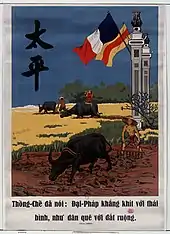 Trụ biểu in a French propaganda painting in Hanoi in 1942
Trụ biểu in a French propaganda painting in Hanoi in 1942
See also
References
- Nguyễn, Doãn Tuân (2011). Đan Phượng, di tích lịch sử, văn hóa, và cách mạng. p. 174.
- Lễ hội Việt Nam. Hương Trang Culture Company. p. 106.
- Nguyễn, Quang Ngọc (2003). Địa chí Nam Định. Chính trị quốc gia. p. 642.
- Bulletin de l'Institut de recherches archéologiques. 1961. p. 225.
- "Trụ biểu đình làng và lời gửi gắm của tiền nhân".
- "Vài nét kiến trúc trụ biểu đình làng Huế". Tạp chí Kiến trúc.
This article is issued from Wikipedia. The text is licensed under Creative Commons - Attribution - Sharealike. Additional terms may apply for the media files.